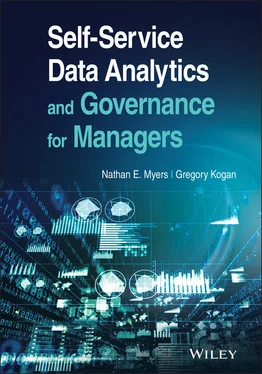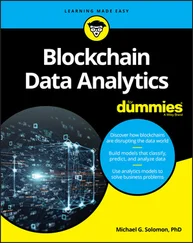You may wonder just where to find promising opportunities to deploy data analytics tooling in your own organizations. We will propose methods for surveying processing operations to uncover use cases with significant benefits warranting prioritization and investment, matching tools to opportunities, and deriving an achievable digital roadmap. We will discuss the levers that can be pulled to increase control and drive efficiency, and decisions that can be made to adapt the organization to expectations that routine processes can be accelerated and streamlined to build capacity, unlock value, and to enhance decision-making. Finally, we will get you thinking about how to prepare your organization for the impending seismic shift, by establishing key governance procedures now, to maintain control as your organization adopts self-service data analytics and business intelligence tooling.
One key contribution of this book to the body of data analytics literature and discourse is our broad-based digest of existing governance frameworks and the systematic revelation of a significant governance gap that must be addressed, as data analytics saturates our respective organizations. There are any number of relevant and overlapping frameworks that cover portions of IT governance and even portions of data analytics governance in the finance and accounting environment. However, no single framework exists that is fit for the universe of self-service data analytics builds. We will draw from mature system governance, model governance, data governance, process governance, SOX 404, COSO IC (internal control framework for the financial reporting process), COSO ERM, and COBIT 2019 (ISACA) frameworks, and even the AICPA’s Statements on Auditing Standards – and distill fundamental governance principles that can be extended more suitably to govern data analytics portfolios. Building on such principles, we will call out recommended action steps that will help managers to satisfy them. Such action steps will be presented in the form of two checklists that readers can take back to their own organizations and implement straightaway. This must be done early and determinedly, so it is in place and can play a formative role in safeguarding your organization, as it embarks on what we believe to be an inevitable digital journey.
No matter which segment of readers you fall into, our goal in writing this work was to present you with a plain-language digest of the mosaic of developing analytics disciplines that warrant your attention. All pretense aside, we offer you our viewpoints and perspectives, with all deference to the insight and views of others that are concurrently embracing these same forces of change. We acknowledge that we cannot get our arms around the growing body of data analytics technology in this work of several hundred pages, alone. It can be fairly said that in the pages to follow, we barely scratch the surface. However, our goal is not to provide a comprehensive treatment of an extremely broad subject area that advances in leaps and bounds day by day. Rather, we set out to distill for you the significant developments in the space, to provide detailed discussions of key topics relevant to universal management goals of control and efficiency, and to empower you to succeed as the imminent data analytics–led digital transformation overtakes us. Best wishes for the journey!
CHAPTER 1 Setting the Stage
Impact
The breadth and scale of data are growing exponentially, and the growth of data is impacting the shape of organizations. In a number of industries, there are multiple departments spanning many functions who process vast numbers of data points into information for delivery to a number of internal and external stakeholders. Along with the growth of data, data analytics technology and tooling are advancing at a break-neck rate to process it, to understand trends, and even to make predictions on future outcomes, before displaying results neatly in low-latency dashboard views for ultimate consumption by managers, executives, clients, counterparties, and regulators. Increasingly, data analytics and automation tools are available to perform more of the routinized tasks in the data-to-information processing chain than ever before. Digital transformation features in the concerns of most Fortune 500 CEOs, and while companies report that their top goal regarding their digital transformation is to understand their customers better or to improve products or services, in practice, there are more practical motivations for digital transformation in finance, accounting, and operations functions. The goals are to build capacity and create efficiencies through automating routinized processes, improve process stability and control by structuring the work done outside core systems, and to optimize human capital resources by reducing low-value-added processing tasks.
It is useful to introduce typical environments where self-service data analytics tools can be adopted to great effect. There is a vast number of companies who employ dozens, hundreds, or even thousands of employees, who spend their days in Microsoft Excel. They may work in a variety of functional silos in the organization, whether they are product controllers, entity controllers, or accountants within the CFO's organization, whether they work in an operations function, or whether they work in a business management or business intelligence function rolling up to a COO or another part of the organization. Microsoft Excel continues to dominate the data processing world in the accounting, finance, and operations functions, but a thick and lengthy manual processing tail performed outside of systems highlights the shortfall of core technology platforms in meeting users' needs. Advancements in data analytics and automation tooling may finally represent viable alternatives, with the potential to supplant and dethrone Microsoft Excel as the default business processing tool, and perhaps finally relegate it to where it belongs – one of several quick and dirty tactical tools available for selection if and as required, but not the default go-to, where the majority of processing teams live, day over day.
In many organizations, the cost of employees is the most significant expense on the income statement. Intellectual capital is carefully cultivated and is very often the strongest asset from which we derive our competitive advantage and stand out from our peers. Why then is our precious bandwidth being wasted on administrative tasks or those tasks that do not push us to use our full potential? It is in the best interests of organizations to free up their people assets from the rigors of routine, mundane tasks which are not befitting of our intellectual capacity and/or skillset. How can managers safeguard the focus of their employees from the burdens of low value-added task overload? The answer may be that these tasks are ripe for automation.
We all know that systems (“big” automation) are integral to nearly every job across nearly every industry, much as mechanization was a game-changer for manufacturing during the industrial revolution. In our digital and information age, where vast data is captured, stored, transformed, and processed for use to inform business decisions, core technology systems offer coded processing and considerable mature technology governance, tied up with a bow and a ribbon. Systems are a central hub for structured development – offering data storage and processing operations, long lists of features and functionality, they offer user experience (UX) styles, and perhaps a rich reporting suite – but importantly, they quietly serve unnoticed as a centralized funnel around which to build internal controls and governance to ensure the accuracy of processing output, financial accounting, and management reporting. The fact that systems are widely subscribed to in an organization ties many operators to enveloping control frameworks built around them. Thanks to mature system governance, many systems are designed with embedded internal controls such as those that ensure appropriate user entitlements, automatic system reconciliations and check totals to ensure data integrity, and workflows may even provide for required supervisory approvals as required. Critically, many companies already enforce robust change governance around technology deliveries, including the production and retention of key project development artifacts such as business and functional requirements, evidence of test scripts and testing results, evidence of sign-off, and the completion of post-implementation reviews following a release.
Читать дальше












